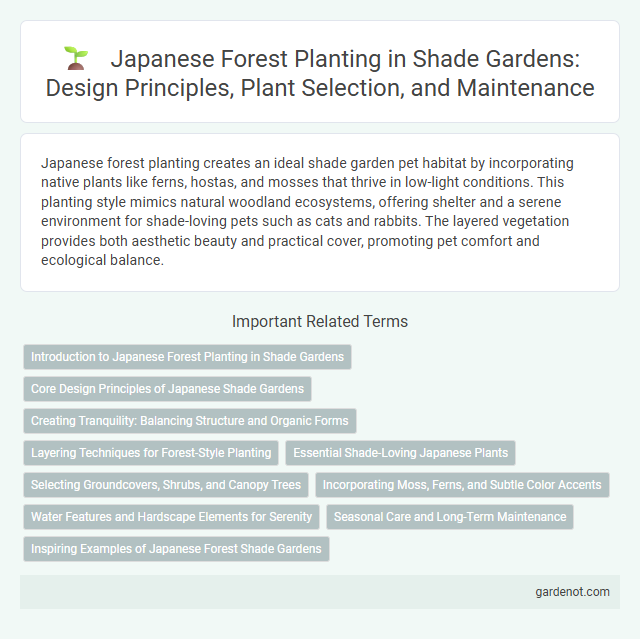Japanese forest planting creates an ideal shade garden pet habitat by incorporating native plants like ferns, hostas, and mosses that thrive in low-light conditions. This planting style mimics natural woodland ecosystems, offering shelter and a serene environment for shade-loving pets such as cats and rabbits. The layered vegetation provides both aesthetic beauty and practical cover, promoting pet comfort and ecological balance.
Introduction to Japanese Forest Planting in Shade Gardens
Japanese forest planting in shade gardens emphasizes the harmonious arrangement of native trees such as Japanese maples (Acer palmatum) and shade-tolerant understory plants like hostas and ferns. This planting style prioritizes layered vegetation, creating a serene, naturalistic environment that thrives under limited sunlight. Incorporating elements like moss and stone pathways enhances the tranquil aesthetic unique to Japanese-inspired shaded landscapes.
Core Design Principles of Japanese Shade Gardens
Japanese shade gardens emphasize the core design principles of balance, simplicity, and natural harmony. Plant selections typically include shade-tolerant species such as ferns, hostas, and mosses to create multilayered textures and varying shades of green. Strategic placement of stones, water features, and subtle lighting enhances tranquility and reflects the garden's seamless integration with the surrounding natural environment.
Creating Tranquility: Balancing Structure and Organic Forms
Japanese forest planting in shade gardens emphasizes creating tranquility through a harmonious balance between structured elements like carefully placed stones and organic forms such as flowing moss and naturalistic tree groupings. Employing native plants like ferns, hostas, and shade-loving maples enhances the layered texture, fostering a serene atmosphere. This design philosophy nurtures a subtle interplay of light and shadow, evoking peacefulness and natural simplicity.
Layering Techniques for Forest-Style Planting
Japanese forest planting employs layered planting techniques that mimic natural forest stratification, enhancing biodiversity and visual depth. Canopy trees like Acer palmatum provide overhead shade, while mid-layer shrubs such as Rhododendron and undergrowth ferns create texture and balance light levels. This multilayer approach promotes ecosystem resilience and creates a serene, immersive shade garden environment.
Essential Shade-Loving Japanese Plants
Essential shade-loving Japanese plants for a shade garden include hostas, which thrive in low-light conditions and offer lush, textured foliage. Ferns such as the Japanese painted fern add delicate fronds with silver and burgundy hues, creating visual interest in shady areas. Shade-tolerant azaleas provide vibrant spring blooms and evergreen structure, perfect for understory planting in traditional Japanese forest-inspired gardens.
Selecting Groundcovers, Shrubs, and Canopy Trees
In Japanese forest planting for shade gardens, selecting groundcovers such as mosses and ferns enhances soil moisture retention and adds lush texture. Shrubs like evergreen azaleas and hydrangeas provide seasonal color while thriving in low-light conditions. Canopy trees including Japanese maple and katsura offer filtered shade, creating a tranquil, layered environment essential for a harmonious forest aesthetic.
Incorporating Moss, Ferns, and Subtle Color Accents
Japanese forest gardens emphasize the delicate layering of moss, ferns, and subtle color accents to create a tranquil, naturalistic environment. Moss acts as a soft, verdant carpet that retains moisture and enriches soil health, while ferns provide textured foliage that thrives in shaded, humid conditions. Carefully placed color accents, such as the muted reds of Japanese maple leaves or the pale whites of azaleas, enhance visual interest without disrupting the garden's serene atmosphere.
Water Features and Hardscape Elements for Serenity
Japanese forest planting in shade gardens emphasizes water features such as koi ponds and bamboo fountains that create soothing soundscapes and enhance tranquility. Hardscape elements like moss-covered stepping stones, natural stone lanterns, and wooden bridges integrate seamlessly with the greenery, promoting a serene atmosphere. These components collectively establish a harmonious environment that fosters relaxation and contemplative meditation.
Seasonal Care and Long-Term Maintenance
Japanese forest planting in shade gardens requires seasonal care that includes timely mulching to retain moisture and prevent weed growth during spring and summer. Regular pruning in late winter promotes healthy growth and enhances the layered structure characteristic of Japanese woodland aesthetics. Long-term maintenance involves monitoring soil acidity and nutrient levels to support native understory plants and ensure ecological balance.
Inspiring Examples of Japanese Forest Shade Gardens
Japanese forest shade gardens exemplify serene landscapes where shade-loving plants like hostas, ferns, and mosses thrive under dense canopy layers of maple and cedar trees. These gardens emphasize naturalistic layering, balancing dappled light with textured foliage to create tranquil, meditative spaces. Noteworthy examples such as the gardens at Ritsurin Park and Shinjuku Gyoen showcase meticulous design integrating native species and seasonal transitions, inspiring sustainable shade garden practices worldwide.
Japanese forest planting Infographic

 gardenot.com
gardenot.com